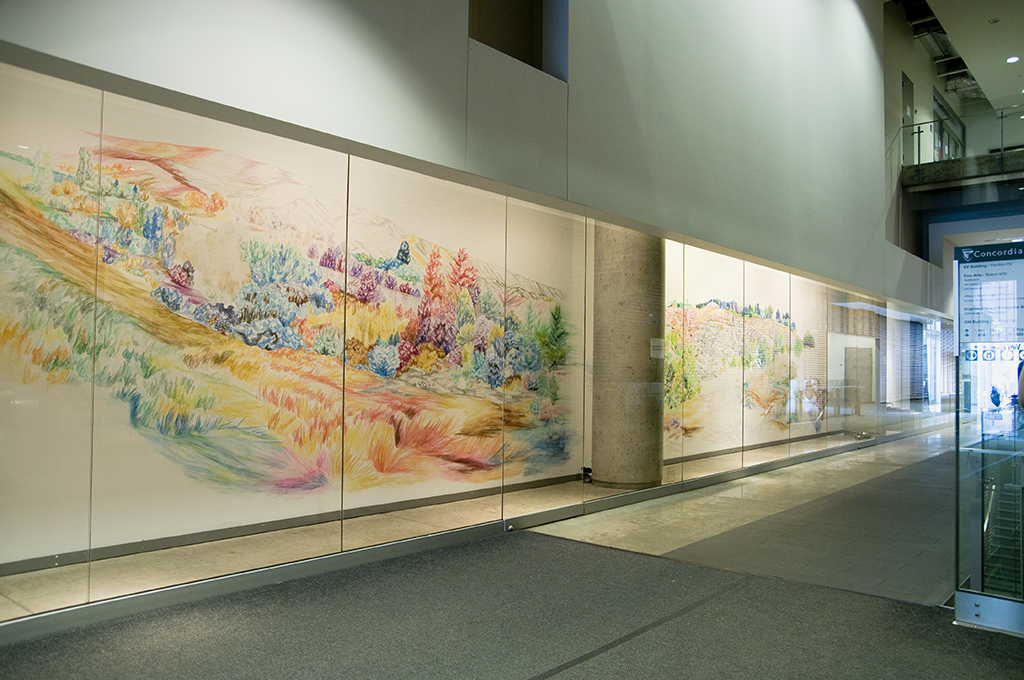Several of Andréanne Godin’s works underline the extent to which the territory is embedded in our memory, through memories of daily or seasonal activities that crystallize as sediment in our psyche(1). Her work also attests to the mourning and uprooting that affect the fullness of this intimate geology. Last text of a series in two times.
What is the nature of these feelings of loss and emptiness relative to the territory that the transformations of the landscape provoke and that the artist explores in his installations?
Mourning
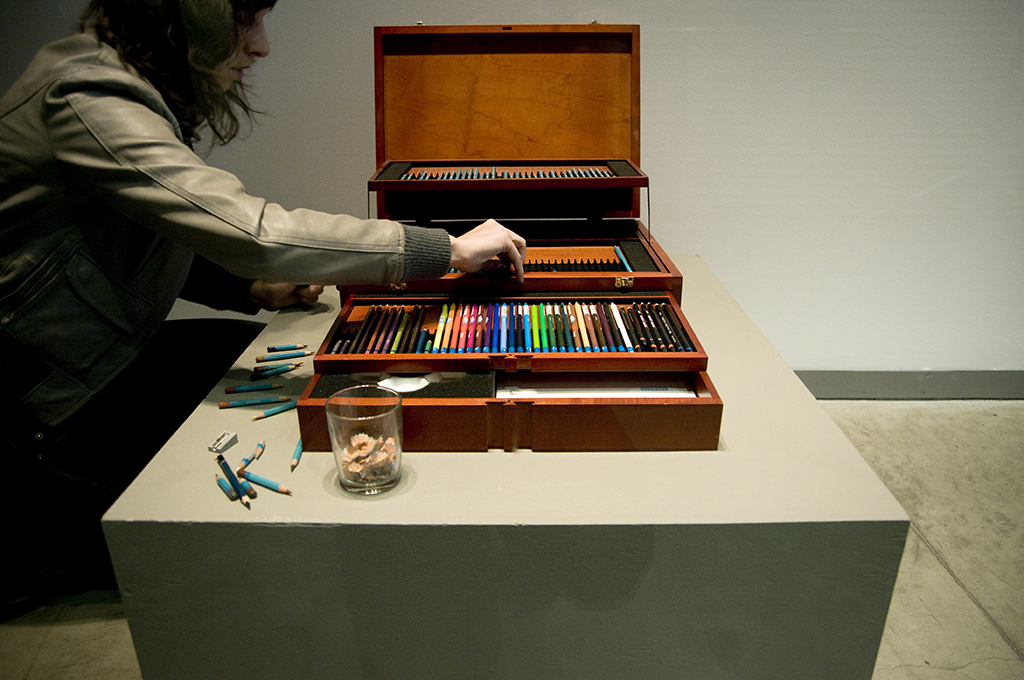
As part of an exhibition at the FOFA Gallery, Andréanne Godin creates an installation-performance entitled Memorial for a Stranger (2011). Throughout the exhibition, at several random moments, she draws in front of the public on the walls of the gallery’s interior showcase. The pencils used come from a box that was given to her, belonging to a woman who died before she could use them. Two typical landscapes of his native Abitibi, the boreal forest and an open pit mine, are gradually unfolding on the walls in the center of the space. At each end, the box of watercolor pencils and their sharpened residues carefully arranged on the floor frame the drawn mural. The ensemble highlights the work invested by the artist in this posthumous tribute. It grants a time and a place to the mourning so that it is accomplished and recognizes the irremediable loss that it represents, what ratifies the progressive wear of the pencils.
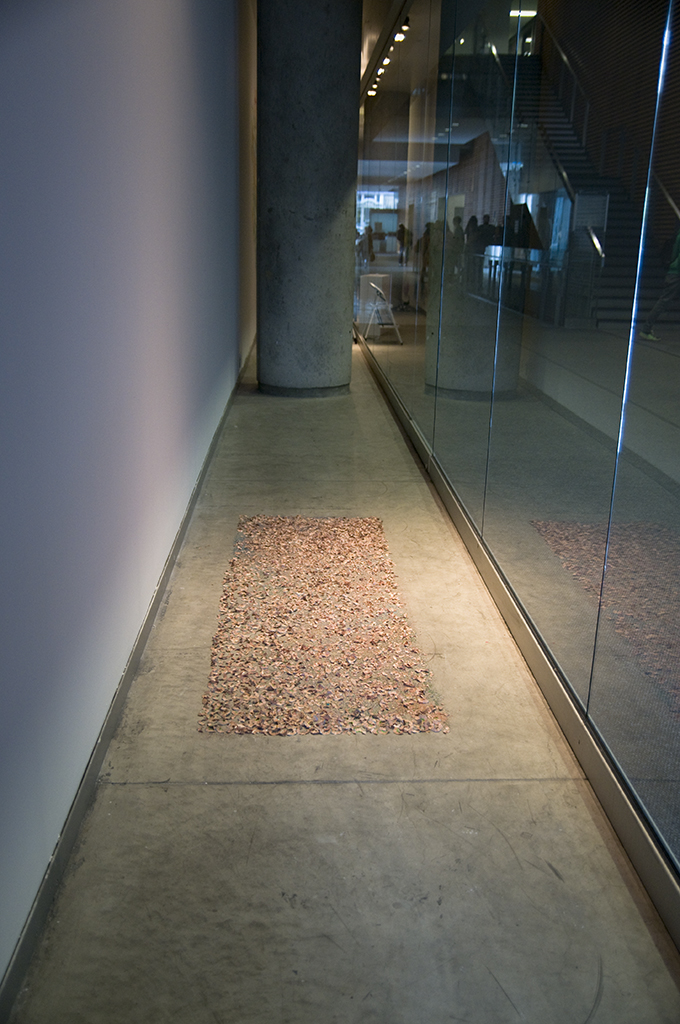
By his creative gesture, the artist expresses this passage, which we guess in echo to personal experiences. At the end of the exhibition, the erasure of the landscape forces the people who lived its progressive deployment to tame its disappearance and to crystallize the memory as a unique residue. It thus poses the loss as a common experience, even universal, and opens the object to any entity that inhabits us like the territory.
Uprooting
In this performance installation, the artist also evokes her experience of the transformations inflicted by the mining industry on the landscapes of her childhood. She continues this reflection with Le mur (2013)(2) and Et là, nous marchâmes… (3)(2014-2015).
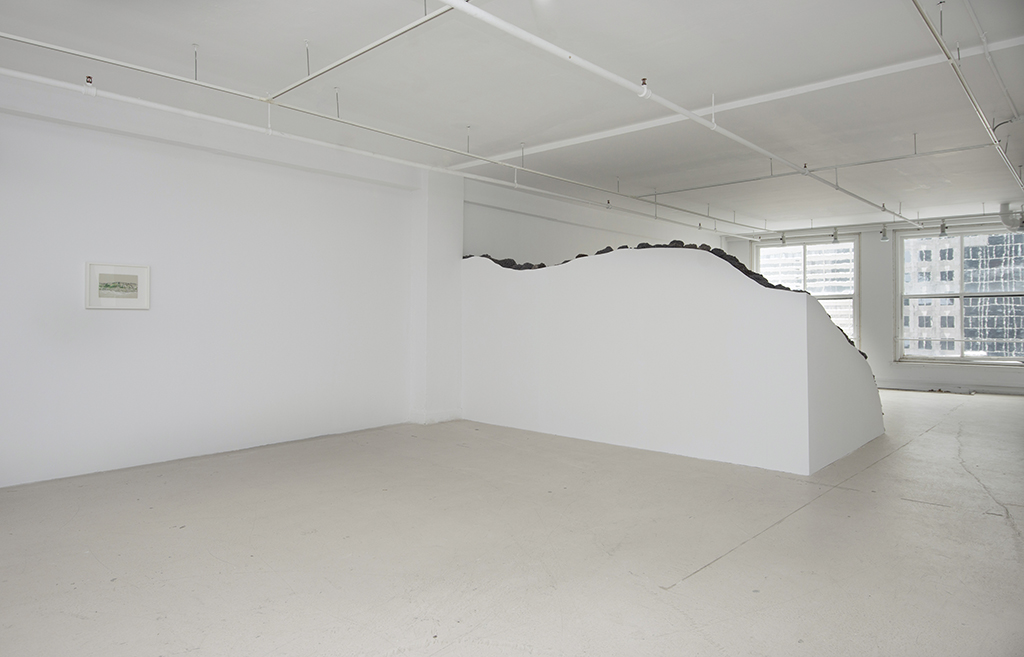
The exhibition Le mur unfolds in autonomous components: a drawing, accompanied by a letter and a collection box, and two installations. The piles of drawn mine tailings echo the accumulation of hand-hooked wire rocks hidden behind a half-canopy of the installation Sterile Mountain (2013). The meticulous handiwork thus makes visible what industry usually conceals from our view, through waste hidden behind decorative palisades, or through the development of parks right on the docks. Associated with an artisanal activity, the gesture also opposes a domestic universe to the mining activity. In Avant le bruit (2013), in front of a base where graphite blueberries are placed, an audio text narrates a seasonal group outing to pick blueberries.
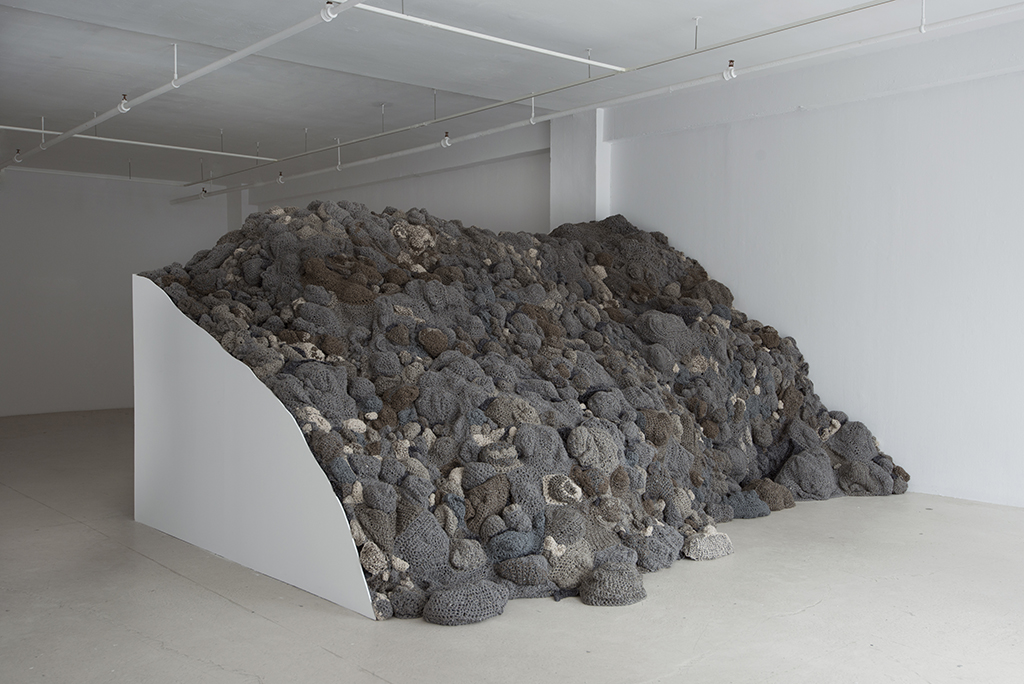
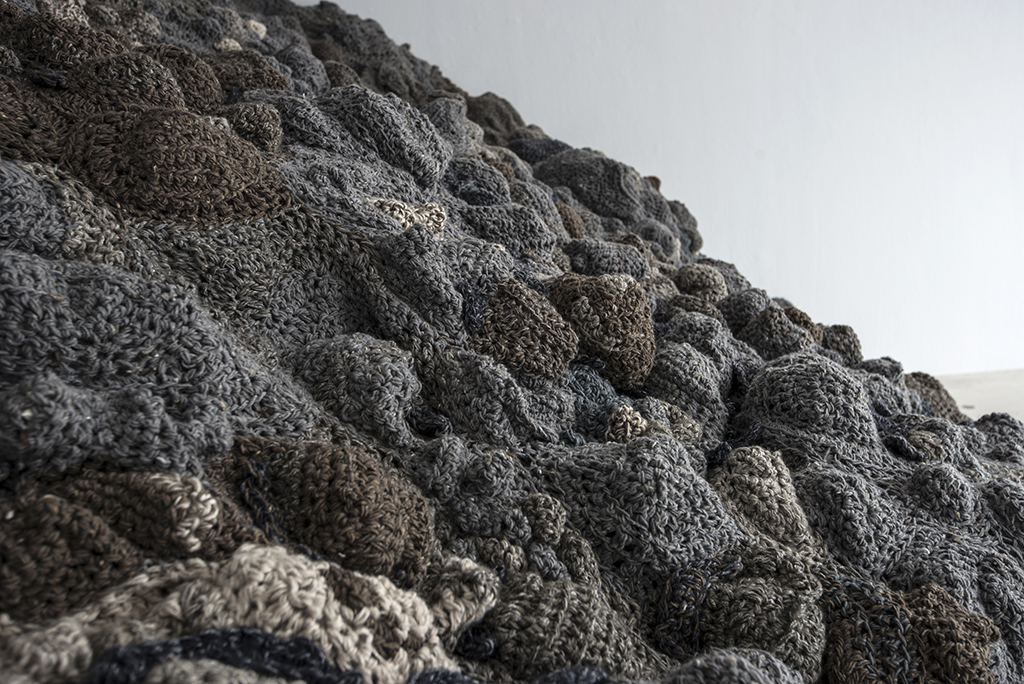
This family reminiscence also appears in the installation Et là, nous marchâmes… Through innuendo, the soundtrack suggests that uprooting also has an intimate component.

Faced with this realization of loss, the artist questions the president of Osisko, the company responsible for the implementation of the open-pit gold mine in Malarctic (4) Through the work Proposition d’achat de paysage (2011), she asks him to purchase a small volume of waste rock from the mine tailings, with the aim of preserving it as a symbolic part of her personal landscape, irreparably altered by the mining industry. In sum, the exhibition as a whole captures the emotional or affective effects of economic activity. In her book La généalogie du déracinement : Enquête sur l’habitation postcoloniale (2019), Dalie Giroux describes in detail this “contemporary spatial experience”, characteristic of an organization of the territory adapted to the workings of a production machine circulating materials and labor, from resource regions to metropolitan consumption nodes, without regard to the experience of the inhabitants (5).
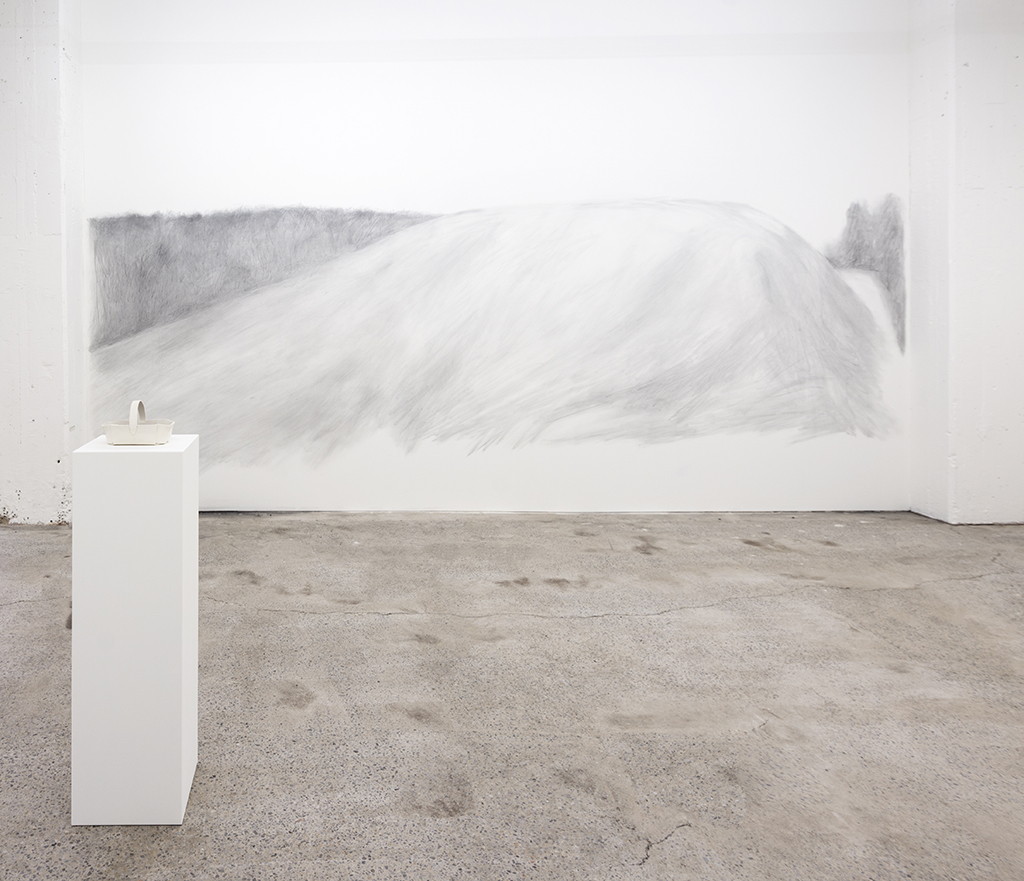
In this sense, Andréanne Godin expresses the intimate tug-of-war, even the traumas, that this contemporary way of living inflicts on us, by virtue of this paradigm of territorial planning. On the one hand, she brings out the deep links that connect us to given landscapes, those that crystallize an intimate personal geology, and on the other hand, she dissects the mourning and uprooting to which this attachment exposes us in the current economic context.
FOOTNOTES
- See the first article of this series Marie Perrault, https://marieperrault.art/en/2023/05/03/terrestrial-psyche-territory-and-territorialities/
- Master’s exhibition presented at Gallery B-312 (Montreal) from February 21 to March 23, 2013.
- Included in the exhibition Andréanne Godin – Through the Scenes of Your Memory, Galerie Nicolas Robert (Montreal), from February 28 to April 11, 2015.
- Osisko Mining Corporation is the largest gold mining company in Quebec. At the time, it was responsible for the development of the Osisko project, which eventually included a 380 m deep pit, over 2 km long and 780 m wide. This mine, now operated by Canadian Malartic, required the destruction or relocation northward of the buildings in the southern part of the town of Malartic.
- In 2022, during a residency at l’Écart, Centre en art actuel de Rouyn-Noranda, I noticed how the status of resource region modulates the culture of the citizens who live there and divides them around a belonging to the territory and an allegiance to the industry.

